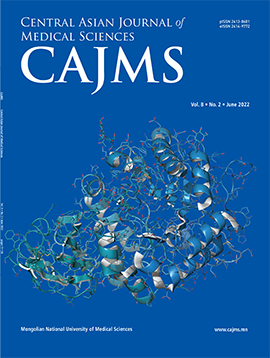Comparison of Treatment Results for Clinical Types of Benign Paroxysmal Positional Vertigo
DOI:
https://doi.org/10.24079/cajms.2021.06.007Keywords:
Benign Paroxysmal Positional Vertigo, Semicircular Canals, VertigoAbstract
Objective: To compare the clinical characteristics and treatment results of different clinical types of benign paroxysmal positional vertigo (BPPV). Methods: A total of 162 patients diagnosed with BPPV between January 2019 to January 2021 at EMJJ ENT Hospital’s vestibular laboratory in Mongolia were included in our study. The diagnosis of BPPV was made according to the 2017 AAO-HNS clinical practice guideline for BPPV. Clinical questionnaires, Dizziness Handicap Inventory (DHI) questionnaires, and videonystgamography were obtained for all patients. Results: From a total of 162 patients diagnosed as BPPV, 62.4% had posterior canal BPPV, 27.1% had horizontal canal BPPV, and 10.5% had anterior canal BPPV. Fischer’s exact test showed a higher incidence on the right side (p = 0.000). The mean age 50 ± 11.7; the male to female ratio 1:4. When the relationship between the effectiveness and duration of the treatment was assessed, 123 (75.9%) recovered after 7 days. DHI score after treatment significantly after treatment (p = 0.000) regardless of the clinical type. Conclusions: Patients who had a longer duration of symptoms underwent unnecessary diagnostic tests and developed additional psychologic problems. There were no statistically significant differences when we compared the characteristics and treatment between the three clinical types of BPPV.
Downloads
226
Downloads
Published
How to Cite
Issue
Section
License
Copyright (c) 2021 Mongolian National University of Medical Sciences

This work is licensed under a Creative Commons Attribution-NonCommercial 4.0 International License.




